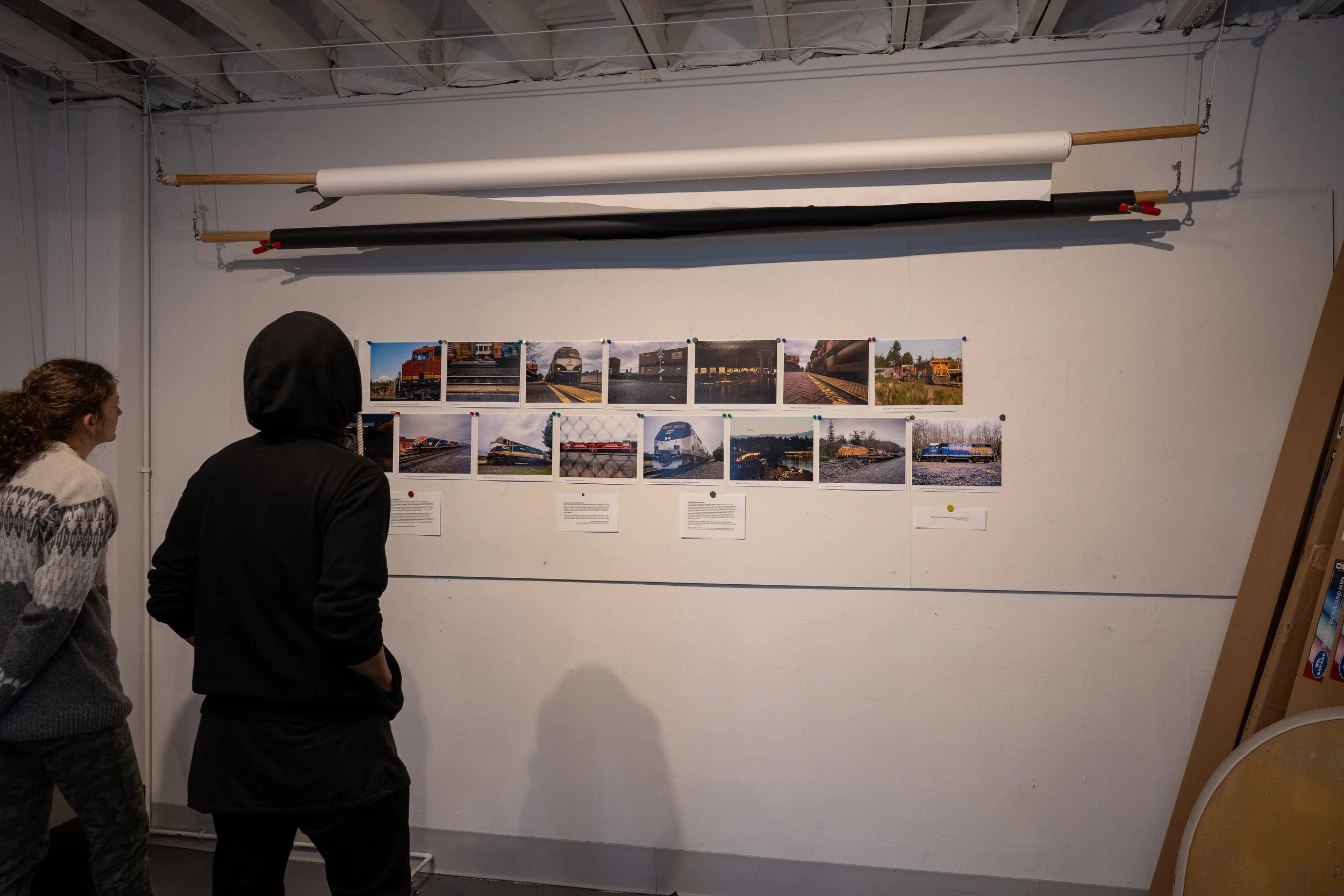Rail Transport in Western Washington - A Snapshot in Time
The only thing constant in life is change
Heraclitus
I recently took a ten week three unit course from the Photographic Center of the Northwest in Seattle. I enjoyed this class immensely and learned a lot from the really good instructor, Adair Freeman Rutledge. Throughout the class we had various assignments, and I may post some of those later. This post is the photos I took (with a lot of help from Bob) for the final photo essay. My essay was about trains. Why trains? Because they are fascinating, and I felt I could possibly get some interesting photos of them.
The final project was to print out ten to fifteen photos to be posted on the wall and critiqued by the class. Bob and I spent most of a week going out to various places where I thought there might be suitable spots to set up. I ended up taking 265 photos and whittled it down to fifteen.
The following is the narrative that I put up alongside the train photos. I found out that trains are even more fascinating than I thought:
Freight Rail
Since the first railroad in North America opened in 1827, thousands of railroad companies have come and gone. In 1911 the Interstate Commerce Commission started classifying freight railway companies as Class I, II, and III by revenue with Class I having the highest revenue. In 1911 there were 132 Class I railroads. Over time, others have formed, but many have either gone out of business or consolidated with other railroads - for instance the famous Atchison, Topeka and the Santa Fe Railroad (founded in 1859) merged with Burlington Northern Railroad in 1995 to create Burlington Northern Santa Fe (BNSF). Founded in 1862, the Union Pacific Railroad has, over the last 100 years, “absorbed” the Missouri Pacific, the Western Pacific, the Missouri-Kansas-Texas, and the Chicago, Rock Island and Pacific railroads, and merged with Chicago and North Western and the Southern Pacific transportation companies. As of 2024, there are only seven Class I railways left - four headquartered in the United States and three headquartered in Canada (one with tracks into Mexico).
The North American freight rail network is currently operated by the aforementioned seven Class I railroads, 22 regional railroads (Class II) and over 580 short line (Class III) railroads.1 The two Class I freight railways found in Western Washington are BNSF and Union Pacific, although there are numerous Class III - Tacoma Rail and Puget Sound and Pacific Railroad (PSAP), for instance.
Passenger Rail
As with freight companies, there have been hundreds of long-distance passenger rail services. While there are still numerous local passenger railroads (e.g., the Sounder in the Seattle area), by the late 1960s passenger rail was being replaced by road vehicles and planes, and congress passed the Rail Passenger Service Act of 1970, consolidating many of the remaining intercity services in the United States (voluntarily) into one - Amtrak.2 Amtrak, Canada’s Via Rail, and Mexico’s Ferromex would also be considered Class I railroads if they carried freight.
The Amtrak Cascades runs up and down western Washington numerous times daily between Vancouver, BC and Eugene, Oregon. The Coast Starlight runs daily between Seattle and Los Angeles, and the Empire Builder runs daily between Seattle (and Portland) and Chicago. The Infrastructure, Investment and Jobs Act of 2021 allocated funds to passenger rail infrastructure, and Amtrak is proposing to almost double the long-distance intercity lines, including adding a more southerly route from Seattle to Chicago, and a new route from Seattle to Denver.
Click image to see captions:
Greenhouse gas emissions
There are two principle means of overland transportation: road and rail. Rail is far more efficient. According to the Association of American Railroads, railroads account for about 40% of long-distance freight volume, but (according to EPA data) only 1.7% of transportation-related (freight and people) greenhouse gas emissions. EPA data also shows that rail only emits 0.5% of total U.S. greenhouse gas emissions.
“Because of technological advancement and innovation, rail continues to be unrivaled by other modes for fuel efficiency. Trains are four times more efficient than trucks, moving one ton of freight 470 miles on just a single gallon of diesel fuel”
- Federal Railroad Administration (https://railroads.dot.gov/rail-network-development/freight-rail-overview)
Hazardous Material
Unfortunately, because rail is highly efficient at moving freight, trains often transport hazardous material. While freight train is generally a safer alternative than road for hazardous material transport, coal is a glaring exception due to fugitive coal dust. Coal cars cannot be covered due to the explosive potential of coal dust. Coal dust is not only explosive, it is dangerous when inhaled, is an environmental contaminant, and a serious environmental justice concern as trains tend to go through the lowest income communities. According to a University of California, Davis study, “passing trains carrying coal add…8 micrograms (of PM2.5 fine particulate matter) per cubic meter of air…” Higher levels if it is windy.3
Diesel locomotives are themselves pollution sources, although they are becoming more and more regulated, and emissions standards are much higher for newer locomotives.
Photographs
This photo series captures a glimpse into the National Rail System in Western Washington as it exists in early 2024, because as you can see, the only thing constant for railroads…is change.
Once you are finished changing, you are finished
Benjamin Franklin
Some photos that didn’t make the cut:
Interesting Side Note
Bob happened to drive past the graffiti-covered PSAP Locomotive, and it had actually moved! It is not abandoned. Bob ran over and talked to the engineer, and apparently it is still in service, and they exercise it once a week to keep it from seizing up.





















